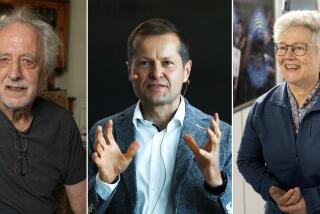With gold and photons, scientists offer way to turn energy into matter
- Share via
God said, “Let there be light,” and there was light. Then four physicists said, “We have a simple idea for turning that light into matter” – and they may set off a race to demonstrate an idea first proposed 80 years ago.
Albert Einstein’s most famous equation, E = mc2, showed that there is a direct relationship between the mass of an object and the amount of energy it contains. Then physicists Gregory Breit and John A. Wheeler built on Einstein’s work by arguing that it ought to be possible to take two photons (pieces of light that are considered pure energy) and convert them into a pair of particles (an electron and its antimatter counterpart, a positron).
------------
FOR THE RECORD
9:13 a.m. May 21: An earlier version of this post stated that three physicists were co-authors of the Nature Photonics study that proposed a way to observe light changing into matter. There were four.
------------
In their 1934 scientific article describing what came to be known as the Breit-Wheeler process, the pair weren’t exactly optimistic that their theoretical prediction would could ever be confirmed in practice. “It is hopeless to try to observe pair formation in laboratory experiments,” they wrote in the journal Physical Review.
Oh well, one out of two ain’t bad.
In a study published online Sunday in the journal Nature Photonics, four physicists from Imperial College London and the Max Planck Institute for Nuclear Physics in Heidelberg, Germany, propose a relatively straightforward method for witnessing the conversion of two photons into two particles. The trio came up with the idea and hammered out the key details in a single, coffee-fueled day, according to Imperial.
The experiment the physicists describe requires the construction of a new type of subatomic particle collider. But they insist this would be much less complicated than, say, building the Large Hadron Collider at CERN, where physicists confirmed the existence of the Higgs boson.
“The implementation of this scheme … is possible using existing technology,” physicists Oliver Pike, Felix Mackenroth, Edward Hill and Steve Rose wrote in Nature Photonics.
Here’s how their proposed collider would work:
Physicists would shoot high-energy electrons into a gold target, creating a high-energy photon beam. Those photons would be fired through the middle of a specialized tube with other photons inside. After pairs of photons collide and convert into electrons and positrons, a magnetic field would separate the particles as they emerge from the end of the tube.
How do they know it would work? They used math to simulate the photons that would emerge from the gold target and how they’d behave inside the tube (a chamber called a vacuum hohlraum). According to their calculations, their photon-photon collider would work with “a wide variation of experimental parameters.”
Experiments at the Stanford Linear Accelerator Center have already demonstrated that if you mix up a lot of photons at high energies, you can create pairs of electrons and positrons. But the SLAC machines would have needed to be about 4 times more powerful to pull off the same feat with only two photons, according to Pike, Mackenroth and Rose.
Rose, a plasma physicist at Imperial and the study’s senior author, said he and his colleagues are now looking for collaborators to build the collider and give their idea a try. He and Pike, a graduate student in the college’s plasma physics group, told the BBC that the collider could be built in less than a year.
“With a good experimental team, it should be quite doable,” Pike said.
Other physicists were skeptical that the device could be constructed that quickly. But they did agree that researchers would give it a shot.
“I think people will seriously start to have a crack at this,” Sir Peter Knight, a physicist and emeritus professor at Imperial, told the BBC. “All the ingredients are there.”







